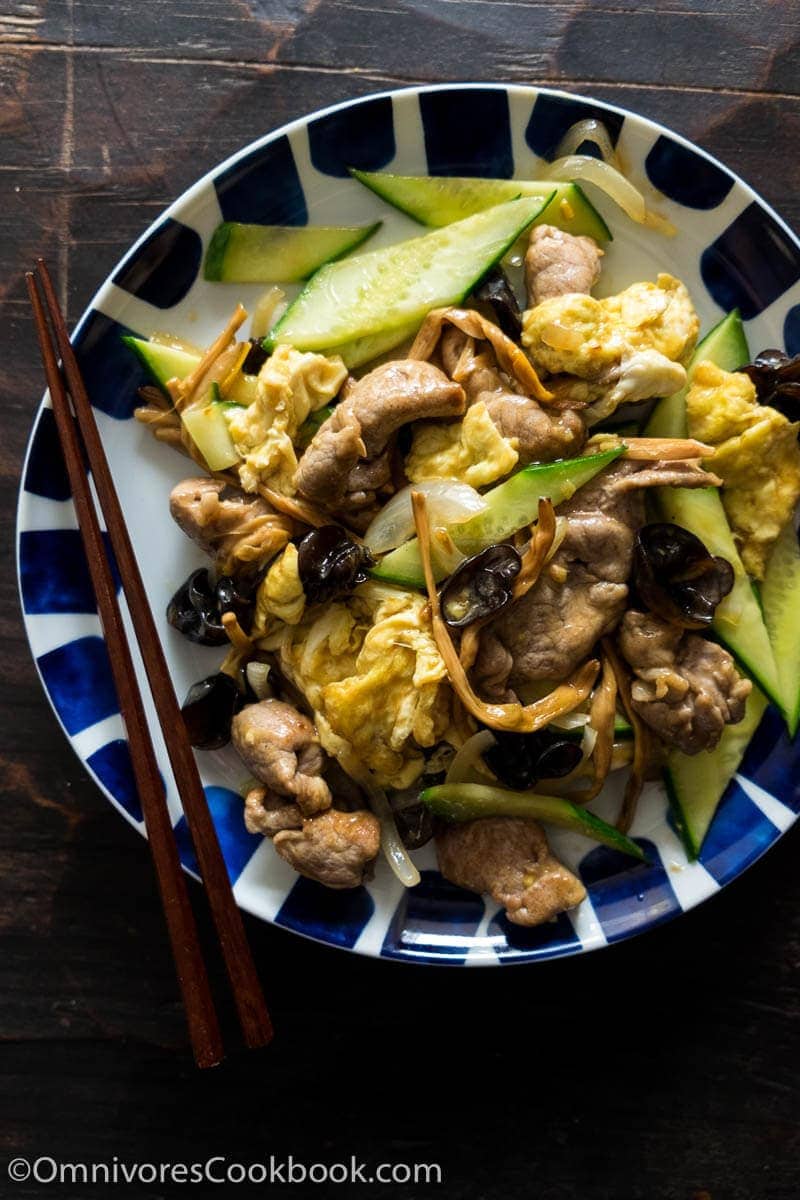
I have a love-hate relationship with Chinese cuisine. It has such diverse varieties and countless delicious dishes. On the other hand, some of the cooking processes are not be very friendly to home cooks just getting into the cuisine. This makes it very difficult for me to spread the love of Chinese food.
Moo shu pork, a type of “poor people’s food”, is a good example. Here, I’m talking about the real-deal moo shu pork eaten in China. Not the one you’re familiar with, the one served with pancakes and hoisin sauce in Americanized Chinese restaurants.
If you read the description of moo shu pork on the Chinese equivalent of Wikipedia, it says “Moo shu pork is a classic northern home-cooked dish that features a quick cooking process and easy-to-get ingredients. It has a refreshing taste and does not use many spices.”
After reading the recipe below, you’ll think to yourself, “Maggie, are you kidding me?”
The ingredient list clearly has more than 15 items and the steps have more than 300 words (excluding my 500 words of notes)!
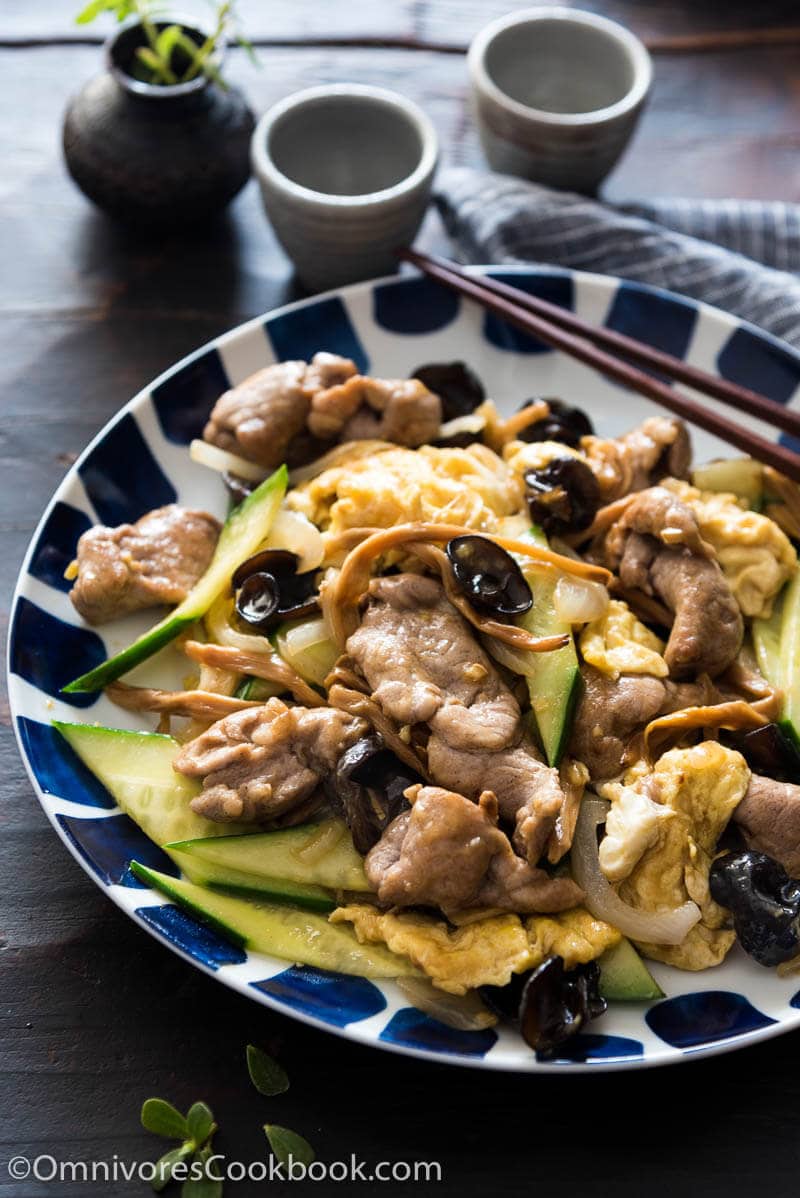
Unfortunately, my friend, this IS the beauty of real Chinese stir-fry. It utilizes all kinds of cheap ingredients you can get anywhere in China, with the minimum amount of protein, a few seasonings, and a wok cooking technique to create a dish that is nutritious and flavorful.
No wonder my mom hates cooking. Imagine you have a full-time job, but still need to cook dinner for your other half and your kid every single day (sometimes lunch, too). For a Chinese family, it means two to three stir fried dishes, a main dish (usually a stew or braised dish), a soup, and steamed rice. I bet if we had “one-pot wonders” or things like 5-ingredient chicken in our culture, my mom wouldn’t hate cooking after all.
Back to the moo shu pork I grew up with – it is a classic northern Chinese dish. Most versions use pork, cucumber, eggs, and wood ear mushrooms, with a simple seasoning of salt and chicken bouillon powder.
The Beijing version uses another ingredient – lily flowers. We use them in vegetarian dishes, stews, and sauces, to impart an earthy flavor and a crunchy texture, to make simple dishes much more interesting. If you do have not this ingredient, it is OK to skip it. However, if you’re into real Chinese cooking, this is a must-have ingredient that you should keep in your pantry.
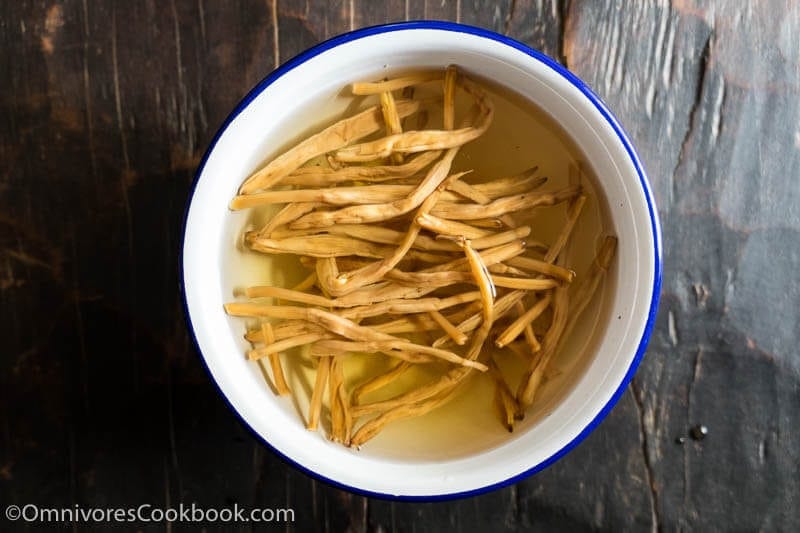
How to cook real-deal moo shu pork
- Marinate the dried ingredients – wood ear mushrooms and lily flowers
There is no good way to measure them, so “a pinch” and “a small handful” are the best measurements I can give you. Some wood ear mushrooms expand more than 10 times from rehydration (see how different they are in the picture below), some do not. Either way, make sure to use a large bowl and more hot water than you think you’ll need. You want to make sure all the ingredients are still submerged in the water after they’re rehydrated.
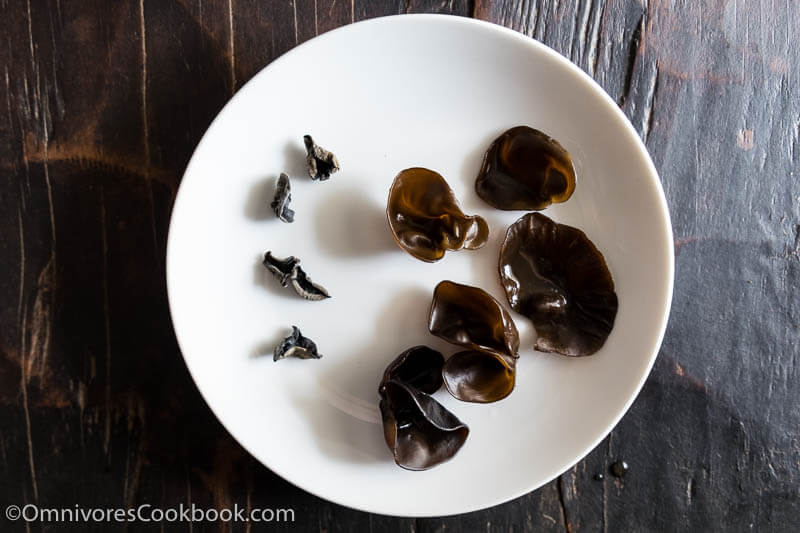
- Slice and marinate pork
We chose pork tenderloin here, because it yields tender and juicy results. Slice the pork as thinly as possible and marinate it. The salt will tenderize the meat while the cornstarch forms a protective layer, so the pork will stay tender during cooking. Because of the thinness of the meat, it takes just 10 to 15 minutes to finish the marinating process.
One thing to note, use your hand to mix the pork instead of a fork or pair of chopsticks. This way you can ensure the marinade coats the pork evenly without breaking the pieces apart.

- Cut vegetables
You just need to cut ginger, onion, and cucumber. To cut diamond-shaped cucumbers, see the dissection picture below.
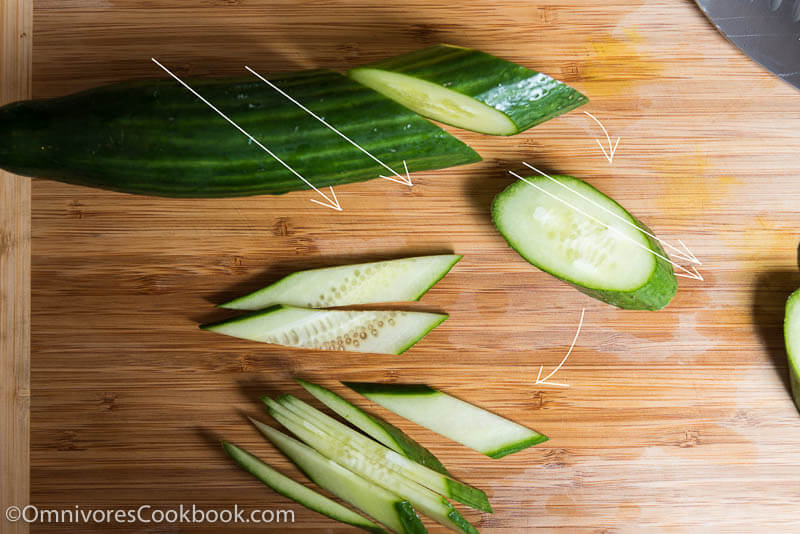
- Mix the sauce
We use a very simple sauce in this recipe – a chicken-stock-based sauce with soy sauce and a touch of vinegar. It might look like a plain sauce, but you’d be surprised how flavorful the finished dish is. The sauce is just rich enough to bring out the freshness of the ingredients themselves.
- Mise en place
I know I repeat this for every stir-fry dish, but it is too important to ignore. When you’re cooking with extremely high heat, one hesitation will cause overcooked pork and a mushy dish.
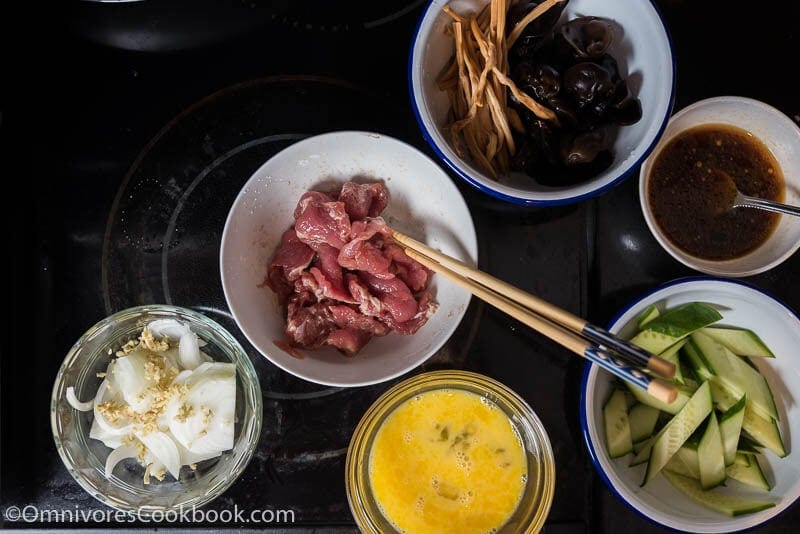
- Get your wok really hot
Make sure the oil has just started to smoke before adding the first ingredient. And you probably need to keep the heat on the highest level throughout cooking. It took me slightly less than four minutes from the time I added the first ingredient until I was finished cooking (I timed it). If you take more time than this, your wok is probably not hot enough.
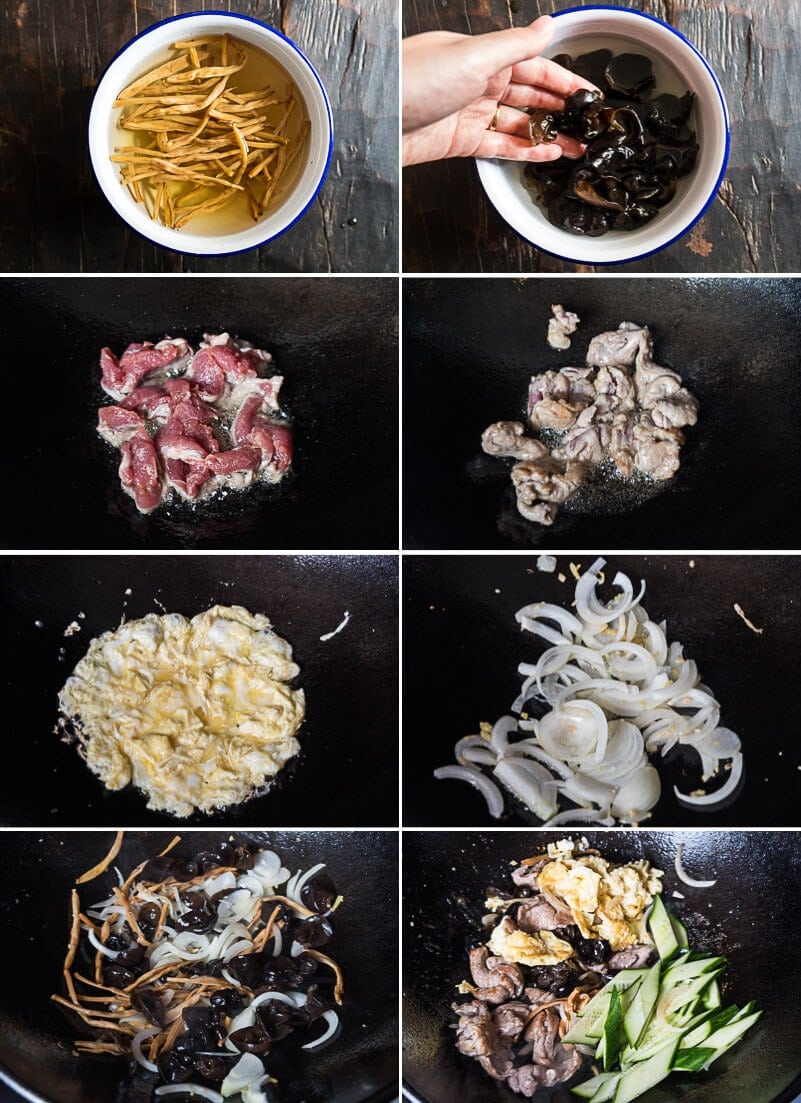
- Be flexible
Lastly, although I tried my best to keep this recipe authentic, please feel free to tweak it with the ingredients you have at home.
- If you cannot find wood ear mushrooms or lily flowers, try rehydrated shiitake mushrooms and carrots.
- Or you can skip them and use just pork, cucumber, and egg.
- Or replace the cucumber with bell pepper.
- Also, you can replace the pork with chicken or beef.
This recipe is just a guide to teach you how to create a healthy, colorful, and delicious stir-fried dish for your weekday dinner.
The recipe might not belong in the “easy” category by your standards. But after some practice, the stir-fry technique will become your best friend, one that allows you to create a quick and nutritious meal with whatever you have in the fridge. Compare the mise en place and the finished dish – you’ll be surprised at the volume of the dish made from a just few simple ingredients.
Happy cooking!
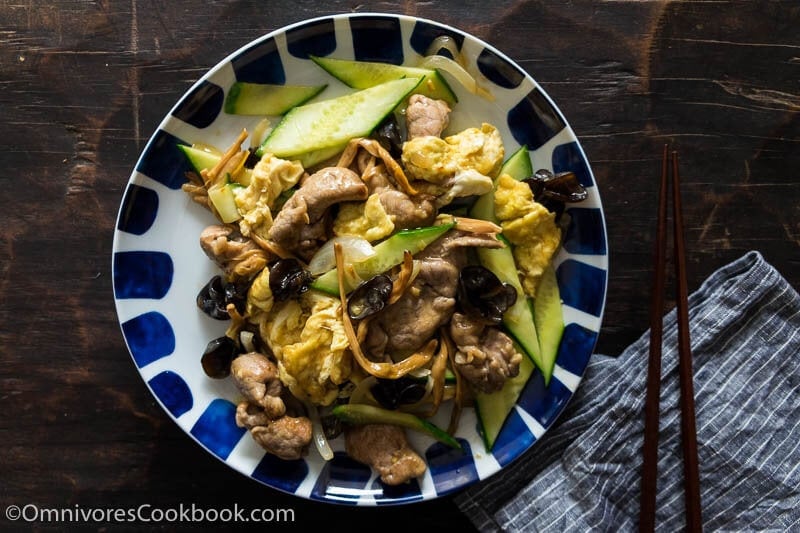
Chinese Cooking Made Easy
Are you new to this website? This free email series is a great place to start. I’ll walk you through a few of my most popular recipes and show you how and why they work. You’ll quickly start to cook better Chinese food in your own kitchen.
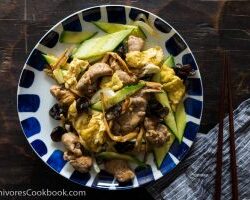
Real-Deal Moo Shu Pork (木犀肉)
Ingredients
Rehydrate
- A small pinch of dried wood ear mushrooms black fungus (yields 1 cup after rehydration)
- A small handful of dried lily flowers (yields 1/2 cup after rehydration) (Optional)
Marinade
- 4.5 ounces (130 grams) pork tenderloin (1/4 of a whole tenderloin)
- 2 teaspoons Shaoxing wine
- 1/4 teaspoon sea salt
- 1/8 teaspoon white pepper powder
- 1/2 teaspoon cornstarch
Sauce
- 1/4 cup chicken stock
- 1 tablespoon light soy sauce
- 1/2 teaspoon Chinkiang vinegar
- 1/2 teaspoon sesame oil
- 1/4 teaspoon sea salt (Optional) (*footnote 1)
- 1 teaspoon cornstarch
Stir fry
- 3 tablespoons peanut oil (or vegetable oil)
- 2 eggs , beaten
- 1/4 white onion , sliced (or 2 green onions, chopped)
- 1/2 teaspoon ginger , minced
- 1/2 seedless cucumber , sliced into diamond shape
Instructions
- Add dried wood ear mushrooms into a small bowl and hot water to cover. Add dried lily flowers into another small bowl and hot water to cover. Rehydrate for 20 to 30 minutes, or until ingredients turn tender. Check after 10 minutes to make sure the water still covers all the ingredients. If the water gets cold, change to another batch of hot water. Gently rub with hands and rinse to remove the dirt. Remove tough ends of the mushrooms and flowers. Drain and place in a small bowl. It is OK if the ingredients are still a bit wet.
- Slice pork against the grain into bite-sized pieces, as thinly as possible.
- In a small bowl, combine pork, Shaoxing wine, salt, and white pepper. Gently mix by hand so that the seasonings coat the meat evenly without tearing the meat apart. Add cornstarch. Continue to mix with hand until the it forms a thin paste that evenly coats the pork. Marinate for 10 to 15 minutes.
- In another small bowl, combine chicken stock, light soy sauce, Chinkiang vinegar, salt (if using), sesame oil, and cornstarch. Mix well and set aside.
- Heat a wok over high heat until hot. Add 2 tablespoons oil and swirl the wok so that the oil coats the bottom (*footnote 2). When the oil just starts to smoke, spread the pork in the oil. Cook without moving for 20 to 30 seconds, until the bottom side turns golden. Flip and cook until the surface just turns white but the inside is still pink. You don’t want to stir too much here, since it might break the pork pieces. Scoop the pork with a spatula and let the oil drip back into the wok. Transfer pork to a plate.
- You should still have about 1 tablespoon oil in the wok. If not, add more oil.
- Add egg. Cook a few seconds to allow the bottom to set. Stir a few times until the eggs are just cooked. Transfer eggs to the same plate as the pork.
- Add a teaspoon of oil and the onion (or green onion) and ginger. Stir until the herbs become fragrant. Add rehydrated wood ear mushrooms and lily flowers. Stir to mix well with the oil. Swirl in the sauce. Cook until the sauce thickens. Return pork, egg, and cucumber to the wok. Stir to mix everything well. Turn to low heat. Carefully try a piece of pork with a piece of vegetable. Adjust seasoning by sprinkling a bit salt and stir well, if needed. Transfer to a serving plate.
- Serve immediately over steamed rice.
Notes
- Include the salt if you’re serving the dish with rice. If you want to serve the dish by itself, skip the salt.
- Use a generous amount of oil at the beginning to help prevent the pork from sticking to the wok. The pork won’t absorb a lot of oil, so you might not need to add more oil (or only need to add a little oil) during the process later.
Nutrition

Did you make this recipe?
I’d love to hear how it turned out for you! Please take a moment to leave a 5-star rating ⭐️ and share your thoughts in the comments further down the page. It really helps others discover the recipe too.

Andrew
Moo Shu pork what is my absolute favorite dish as a kid growing up in New York City. My dad would take me to Chinatown in the 70s, and I have amazing Moo Shu pork! While this dish was different than the American version, it was so good! Love the flavors and can’t wait to make it again!
Susi V
Made this last night as a light and easy dinner. This is *such* a winner recipe – the light seasoning lets all the different flavours and textures shine. It looks pretty and impressive and the contrast between the succulent egg and pork and the crisp cucumber pieces is amazing. I cook Chinese food often (and love the pancake version of this too!) and it was great to discover this recipe which is easy enough for a weeknight and also quite different to add variety to the rotation!
Susi V
Forgot to rate! 5 stars for sure!
Maggie Zhu
So happy to hear you enjoyed this one! This is how we serve moo shu pork in China and it’s quite different from the US pancake version, and I was afraid it might look too unfamiliar. Thanks for leaving a positive review 🙂
Kate
Thank you so much for this recipe! I lived in Liaoning province for 3 years. Even after 15 years, I still miss the food so much. I have been craving this dish for years, couldn’t find it in any restaurant, the other recipes I tried didn’t taste authentic. THIS recipe turned out amazing!
Maggie Zhu
I’m so happy to hear you tried the recipe! In the US the dish is so different so not many people have cooked it yet. Glad to hear you enjoyed this one 🙂
Gene Spector
This was also a disappointment. The dish was flat with little flavor
Frank
Hi Maggie. I made this last night and must confess – I used pancakes and hoisin sauce, but wife ate it with rice. I found this recipe a bit too small for two very hungry people and will just increase ingredients next time, still it was better than the ones I had made in the past. Previously I had sliced bamboo shoots, no cucumber or Chinkiang vinegar
jason
love it! Thanks for sharing and thanks for great recipes
Stephen Chu DDS
We didn’t call it wood ear. My parents came from northern China in 1949, and they called it “ear- tree mushroom.”
Lois
I switched the wine for sherry and cucumber for courgette, also no flower buds, but it was truly, exceptionally delicious. Not difficult at all despite the long recipe. Marinade the pork and fry, scramble the eggs, stir fry the veg, combine all with the sauce and serve. Very light balanced taste due to the touch of vinegar . I will definitely make this again. Xoxo
Maggie
I’m so glad to hear you tried the recipe and enjoyed the dish Lois! Thank you for taking time to leave a comment 🙂
Maggie
Thank you for your kind words Lois! It’s quite different from the American Chinese version but this is the recipe I’ve been eating growing up. I’m so happy to hear that you like it as much as I do 🙂
Dana C
Loved it! Easy to make and delicious! Made according to the recipe and wouldn’t change a thing!
Steph
I made this last night with bell peppers 🙂 It was so delicious and easy! Thank you for the recipe. Also, I just purchased a new wok, so your step by step instructions are really helpful. Thank you!
Maggie
Hi Steph, I’m glad to hear you’ve tried this dish and liked it! It does look very different from the US takeout version, isn’t it? It’s so awesome you decided to learn wok cooking! Nowadays I use my flat skillet more often because we don’t have a gas stove. But I definitely miss the fast and nice sear using a wok 🙂
Joseba
Gracias Maggie. Por abrirnos una ventana a la gran cocina china. Realista, flexible y divertida. Seguimos !!
Un saludo.
Thanks for opening our minds to the great chinesse cooking. You´re realistic, flexible and funny. We´re keep on !!
Chantal Pistol
J’ai gouté ce plat à Pekinc’est délicieux je vais faire cette recette demain!
Nous mangeons chinois 3 jours par semaine bien que vivant en France!!!
J’adore votre blog.
Chantal
Maggie
I’m glad to hear it Chantal and hope you enjoy the dish! Do drop a message anytime if you’re looking for a specific recipe. I’d love to develop it for you 🙂
Bonne journée!
Robyn @ Simply Fresh Dinners
You are rocking your kitchen, girl! An awesome post with great info, great pics and a fabulous, delicious recipe.
We do not have the moo shu pork with pancakes and hoisin sauce here and that combination sounds bizarre to me, lol. I’m glad I haven’t come across it!
I love that you’ve made this so adaptable too. Looks so good!
Kevin | Keviniscooking
Really enjoyed reading this one Maggie. I had no idea the real deal was not the one I am familiar with, hoisin sauce with pancakes, but this dish. The cucumber addition is news to me! I use the lily flowers often as well as the dried wood ear mushrooms I re-constitute in hot water for my Hot and Sour Soup and other Chinese dishes, though never in this one. Thanks and a must try!
Helen @ Scrummy Lane
Actually, Maggie, I’ve found loads of simple recipes here on your blog, which I love.
BUT, I also really love it when you show us how to make the more complicated recipes. I may never trust myself to make these, but I still love reading about them 🙂
This is a gorgeous recipe – love the egg addition!
Tricia @ Saving room for dessert
What a wonderful dish Maggie – the combination of flavors and textures makes this so appealing. Love your step-by-step photos!
Chris Scheuer
Yum, Sounds wonderful and nothing like Americanized Moo Shu. I think, as usual, your version sounds infinitely better. I love learning all this “real deal” stuff from you Maggie.
sue | theviewfromgreatisland
Maggie I love your step by step photos, I’m going to tackle this this week, I can’t wait! I would have never thought to add cucumber!
Pamela
What do you do with the Cucumber? Is it cooked into the meal or separate on the side?
Maggie
Hi Pamela, the cucumber is added at the end of the stir-frying and cooked into the meal. It will only be briefly cooked so it will remain crispy.
Tammy
i am so excited to try making the Moo shoo rue! I bought wood ear while in Hong Kong, but I had no idea what it was called!
Maggie
Hi Tammy, I’m so glad you hear you could get some wood ear! Most people don’t know this ingredient at all. Hope the cooking goes well and let me know how the dish turns out 🙂
shobelyn
This looks really good. Your pictures capture the beauty of this meal making me want to make it.
Maggie
Hi Shobee, this is good news to me! I was afraid this dish (and the wood ear inside) looks too unfamiliar to most of people but now I’m relieved. 🙂
Scott
Fantastic photos again Maggie.
I am enjoying cabbage a whole lot more than I used to these days, especially in asian dishes. Pork and cabbage would have to be my favourite so I look forward to giving this dish a go.
Maggie
Thanks Scott! Asian cuisine do offers a lot of methods to cook veggies. For me, it’s a good way to enjoy good amount of greens and keep a healthy diet. 🙂